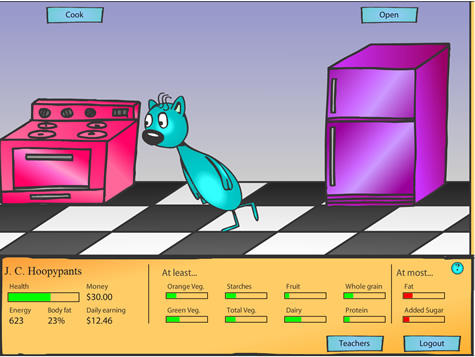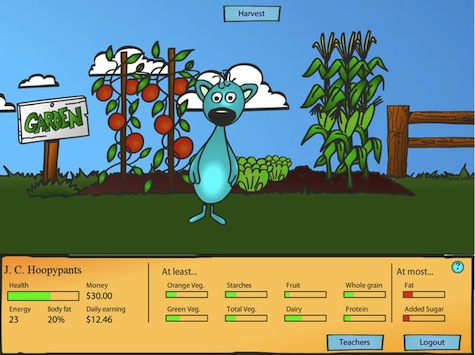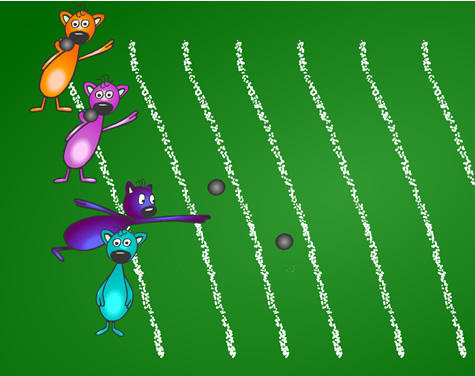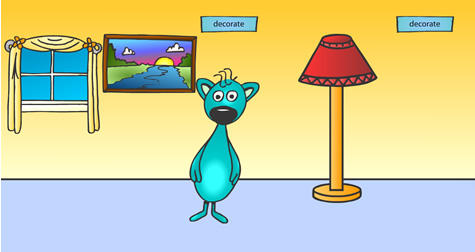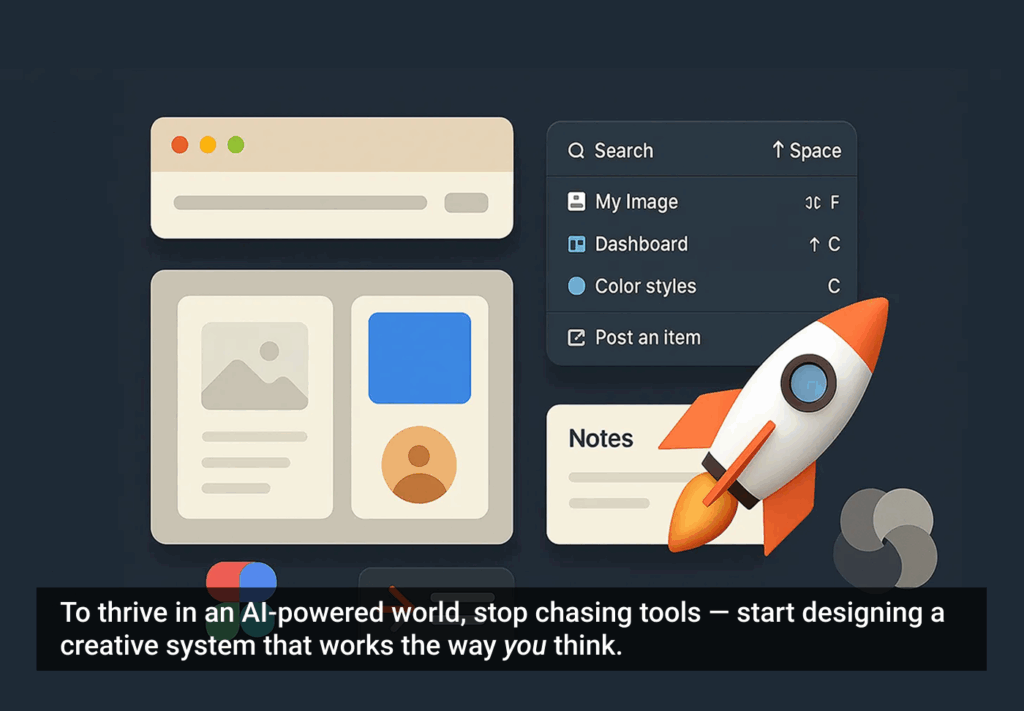I know what you’re probably thinking. Video games may be extremely cool. They may be innovative. They may make tons of money. But they’re ultimately, unavoidably, just entertainment. And persuasion is serious business; if you want to convince people to change their minds or to act differently, games probably aren’t the way to do it… right?
But I say firmly and with conviction: wrong. Every medium is a channel that can convey many types of content. Books, television, and charcoal sketches each have the capacity to entertain, educate, and make powerful statements. But the unique ability of video games to command a player’s attention may in fact make them an ideal way to persuade.
I’m not alone in thinking that there’s potential in persuasive gaming. In March 2010, the USDA and Michelle Obama‘s “Let’s Move” campaign announced a contest challenging designers to create games that would persuade kids age 9 through 12 to eat healthier. I worked with a brilliant team (Andrew Karetas, Bri Lance, Jim Chiponis, and Amanda Ferrara) that created an entry titled Fitter Critters
Below I explain how we attempted to combine principles of both UX and game design to demonstrate the persuasive potential of video games.
The Core Message
A persuasive game has to be built around a focused message. Vaguely defined messages lead to confusing game experiences, so it’s important to get specific before moving on to finer details of the design.
When our team was designing Fitter Critters we had a general sense that we wanted to create a virtual pet game, but we didn’t really know how it would work. So we took some time to write down what messages we wanted our game to impart, and came up with two core messages:
- Eating a varied diet rich in vegetables, fruit, and whole grains leads to a better quality of life.
- Eating junk food may have short-term advantages, but in the long run it’s not worth the negative health consequences.
Now that we had something to work with, the basic game mechanics snapped into place:
- The players need to shop for food their critters and feed them on a daily basis.
- A set of scales show the critter’s progress toward daily nutritional needs like vegetables and whole grains, as well as limits on fats and added sugar.
- If the player consistently makes better nutritional choices, the critter will be healthier and lead a more prosperous life.
Players need to provide the critter with food to fill the bars at the bottom of the screen.
A clearly articulated core message also helps designers decide which proposed gameplay ideas to adopt. An effective message needs to be communicated clearly. Digressive game mechanics risk muddying the message and need to be dropped. For example, one of our early ideas was to have the game track when the critter gets full, after which it would reject any more food. But the concept had no meaningful punch. A critter’s fullness had nothing to do with whether you’d fed it healthy food or junk food—it was just full. This gameplay element also would have forced players to return to the game several times a day to feed their critters, interfering with the message. By leaving aside this feature, we gave our game a more focused design, and kept the project’s scope limited to building only those features we absolutely needed.
Designing Discovery
Players naturally tend to seek out the most efficient ways to meet the objectives of a game. Discovery is an especially effective way to teach through games because it gives players a feeling of ownership of new information. Rather than being directly instructed that the core message is true, players internalize the message as a working hypothesis and use the game to prove to themselves that it’s true. To succeed in the game, they need to buy into its point of view.
Exploiting this principle of gameplay design,Fitter Critters creates opportunities for discovery in multiple ways. First, players need to shop for their virtual pet’s food. The grocer offers over 600 food choices, each with a label listing its nutrition information. One of the key challenges in the game is sifting through the multitude of options to discover the food items that will fill the nutrition requirements as quickly as possible while keeping fat and sugar as low as possible. For example, players may discover that sorbets are among the best dessert choices available, since they’re free of fat and added sugar and actually provide valuable servings of fruit.
Players also discover the advantages of maintaining a garden and using it as a source of food. Harvesting free food from the garden allows players to use their resources more efficiently and save money for other things (as in real life). Creating such optional activities that offer real advantages to players who invest the extra effort is a great way to enable persuasion through discovery.
Players can shop for food or harvest for free from the garden.
Finally, Fitter Critters lets players get creative by combining foods into cooked meals, which can be sold for up to a 500% profit depending upon the healthfulness of its ingredients. Using tactics like this, game worlds can create a perception of tangible value for discoveries that might be harder to perceive in the real world.
All of these discovery opportunities were designed to persuade children to think differently about the foods they eat every day, while at the same time modeling the real-life skills needed to make thoughtfully discriminating choices about their diets. To be successful, players of persuasive games need to internalize the game’s core messages and get used to applying them in the real world.
Meaningful Choices
A game designer’s trap was hiding inside the game’s overall concept: if healthy food offered only benefits and junk food only drawbacks, then the game would present no real choice at all. Players would always pick the healthy food since there would be no reason to consider anything else.
Interesting games offer players meaningful choices. Imagine if a racing game offered players the choice of two cars, one fast and the other slow. Which would you pick? Not only would winning this game feel distinctly unfulfilling, but the player would also never need to weigh the real advantages and disadvantages of different types of cars. Games with simplistic choices create no opportunities for players to learn.
It sounds weird, but there has to be some advantage to making some wrong choices. It’s best if choices fall on a smooth continuum from right to wrong, with a competing set of advantages and disadvantages all along the way.
In Fitter Critters, there are two built-in advantages to consuming high-calorie foods. First, your critter needs to have a certain minimum level of energy to participate in the sports games. Calorie-rich foods fill up your critter’s energy bar quickly, giving it immediate energy to play more games. Second, a higher energy level also allows the critter to earn more money each day from work (although this caps at 2000 calories). That bacon double cheeseburger offers a fast track to higher energy levels.
Energy allows players to participate in sports.
Of course, unhealthy food choices also have important consequences. Exceeding daily limits on calories, fat, or sugar brings down the critter’s health over time. An unhealthy critter will lose the sports games more often and earn less money at work. It will be more likely to get sick and lose an entire day’s wages. The critter will also develop a taste for junk food and start to reject healthier choices, making it harder to get it back to a healthy lifestyle.
This gives players a meaningful choice. It also supports the second core message of the game: whatever short-term advantages there are to eating junk food, they’re outweighed by the damage done to health and quality of life. And by creating meaningful choices involving real trade-offs, this message is learned instead of simply taught.
Rewards
Games build engagement with players by offering structured rewards in exchange for actions—actions ranging from jumping over barrels to killing enemy soldiers. In Fitter Critters, all player rewards are based on nutrition choices. We arranged the rewards in the game in a laddered structure, so that one type of reward leads to another. This gives the game a dimensionality that unfolds over the course of play.
At the bottom rung, eating well increases health and reduces body fat. Players are offered simple praise as they meet their critter’s nutritional requirements, and get the satisfaction of watching its bars fill. All games offer these kinds of fleeting rewards, but they’re not enough to sustain interest for very long.
Moving up one step, healthier characters earn more money. Critters are paid a salary once a day, and the amount of the paycheck is determined by their health and energy (which also affect productivity in the real world). Staying healthy puts critters at lower risk of getting sick, and sick days cost an entire day’s wages. Healthier critters will also win sports games more often. When players win sports games, their critters are paid $50 in game cash. It can be fun to watch your purse grow, but game money is ultimately worthless without anything to spend it on.
Farther up the ladder, players can use money to decorate their critter’s home. The decorations range from inexpensive lamps to topiaries to an extra window. In the near future, players will also be able to build extensions to the house and upgrade home furnishings. Customization is a much more tangible reward, but what good is it if no one else can appreciate your creativity?
Earning money allows players to trick out their homes.
At the top rung, more decorations earn you a higher ranking on the game’s leaderboard. Starting in the fall of 2010, critters will also be able to visit one another’s houses to see how they’ve been tricked out. Social rewards like these are among the most powerful motivators that games can offer players.
But all of these rewards ultimately depend on the nutritional choices the player makes for his or her critter, making it the essential foundation of the critter’s lifestyle. In a persuasive game, effective rewards need to have a clear relationship to the design’s core message.
Games in the Real World
If we dismiss video games as nothing more than frivolous entertainment, we’re cheating ourselves out of a potent way to communicate with an audience. When players feel engaged with a game, they are highly focused on figuring out what it’ll take to win. This state of heightened attention creates an opportunity to bring about real change in people by building a message into the structure of the gameplay. Much attention is paid to whether games contribute to social problems, but not enough attention is given to their capacity to solve them.
John Ferrara is the author of the upcoming book Playful Design: Creating Game Experiences in Everyday Interfaces, to be published by Rosenfeld Media in 2011.
You can play Fitter Critters at www.appsforhealthykids.com/application-gallery/fitter-critters. It is currently open for public voting, so if you find it fun and interesting, its creators would welcome your support!


